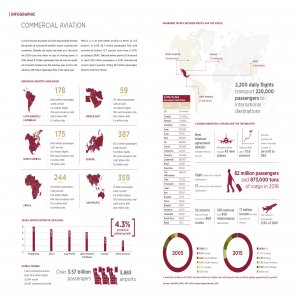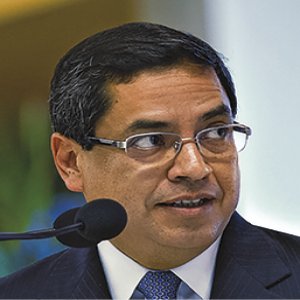Innovation, Renovation Bedrock for Growth

STORY INLINE POST
Q: What would you highlight as the main competitive advantages that have allowed Lufthansa to achieve positive results?
A: The Lufthansa Group is the leading aviation conglomerate in the world. We had a turnover of €32 billion (US$38 billion) in 2016 and combining our different airlines we currently have 674 operational aircraft that result in over 1 million flights annually. We serve 308 destinations in over 103 countries and only in 2016 we transported 110 million passengers.
Lufthansa’ strategy is based on three pillars. The first is oriented to our hub airlines: Lufthansa, SWISS and Austrian Airlines. These are our premium carriers that cater to both business and leisure travelers. Regarding point-to-point traffic, Eurowings and Germanwings offer flights within Europe as well as other long-haul options. Finally, our service-oriented line is comprised by Lufthansa Technik, Lufthansa Cargo, LSG Sky Chefs, Lufthansa Systems, Lufthansa Flight Training and Lufthansa Consulting.
In addition to our core values of safety, reliability and quality, our main competitive advantage against other airlines is our people. This is closely related to the way German companies work and how much they invest on their human capital. Lufthansa’s employees are distinguished by their attitude and high level of proficiency, and now our business approach is based fully on the customer with our Nonstop you strategy. Customization and individualization have become a key part of our business and the human factor plays a crucial role in that.
We had a very successful first half in 2017 and we had our best year ever in our Mexican operations. We have also been voted by SKYTRAX as Europe’s best airline. This market research company surveys over 18 million passengers in 116 countries. Our investments in technology, digitalization and customization have paid off and these recognitions let us know that customers appreciate our products and our strategy. Our goal now is to be recognized as a five-star airline not only in First Class but across all our services and to be a premium alternative among hub airlines.
Q: What impact will the bidding for Air Berlin have on Lufthansa’s operations?
A: This is still an ongoing negotiation. Lufthansa is bidding for part of Air Berlin and we have already leased 38 airplanes from Air Berlin to enlarge our Eurowings division. The airline business grows 5 percent on average every year. There is a need for mobility but leisure is growing significantly more than business flights. Eurowings targets leisure traffic and we had suffered some limitations in our available aircraft. With the leasing of Air Berlin’s equipment, we have managed to grow our capacity and the bidding for the airline is the next step in our strategy.
Q: How have you innovated to offer the best options to the customer?
A: Innovation is a key part of our strategy, not only regarding our fleet but also our on-board products and services. We recently introduced a new class called Premium Economy and we have invested significantly in renewing our services in all our available classes: First Class, Business, Premium Economy and Economy. This includes new upgraded seats, upgraded entertainment systems, wireless internet access and a new signature restaurant service for our Business class. New products require new processes as well but we have received positive feedback from our passengers, both private and corporate. As another example of innovation, we have stopped distributing printed newspapers and magazines. Clients can now download different titles from our e-journal platform, which helps us reduce weight and thus fuel consumption. This year we are also focusing on digitalization and between now and 2020, we will invest €500 million (US$596 million) in digitalization, customization and other innovation projects.
Q: How do these innovations impact the prices of Lufthansa flights?
A: Our investments are not directly related to an increase in fares. We live in a competitive environment and prices must be aligned with what the market expects from us. There are times when our prices can go up but that relates more to demand and how sold out our flights are. In the service industry, you need to invest and offer clients the best products, which have to be combined with profitable routes. That does not translate to a cost-based pricing approach. The market is dynamic and we must strive to be the best airline not only in Europe but around the world.
Q: What plans does the company have to renovate its fleet?
A: We have a strong renovation plan that will be completed by 2025. We have over 180 plane orders valued at €33 billion euro at list price. In 2017 the Lufthansa Group will receive 40 new planes. Having new aircraft allows us to reduce our carbon footprint and implement more efficient processes, while offering the latest technology to our passengers. We have already received our fifth Airbus A350, SWISS is employing Bombardier C Series planes and we are getting the new Airbus A320neo.
Q: How has Lufthansa’s offering grown in number of flights and what further opportunities do you see in Mexico?
A: Lufthansa has been in Mexico for 51 years and we have grown continuously from our initial operations, when we had two weekly flights stopping in Montreal. In April 2014, we added our second flight to Munich, which now operates along our flight to Frankfurt. Outside Germany we have destinations such as Vienna and Zurich, which makes us a multihub company and allows us to offer different choices to our passengers. Our schedule is complementary and clients can arrange their flights based on their needs. The market needs that kind of mobility and there are many German companies with operations in Mexico that benefit from this offering. We think an effective connection between Mexico and Germany will be more important than ever because of the commercial relationship between both countries. Almost 80 percent of all Mexican exports go to the US, which means that some business opportunities with other countries might have been missed. Private passengers have also found a competitive and comfortable option in Lufthansa and because of that we have a very loyal customer base. Mexico is a young country with a strong cultural and historical relationship with Germany that will be beneficial for new generations.
We have supported tourism growth to Mexico and now we have two weekly Lufthansa flights to Cancun from Germany, Eurowings has also two flights per week to Cancun and Edelweiss, a subsidiary of SWISS, has two more. Our increased capacity has not only favored European tourists but also supported the Mexican economy with more tourism cashflow. However, we have not limited our presence only to Mexico. Our different airlines have grown their footprint in the Latin American market and the Caribbean as well. These countries have shown strong signs of growth and our strategy is to take advantage of that and keep expanding our presence.
Q: What opportunities do you expect NAICM to deliver?
A: Before setting new targets for the country we need to know when the new airport will be finalized. We understand that infrastructure projects tend to have delays even in countries like Germany. However, it is true that AICM has no more slots to offer. The infrastructure is saturated and modernizing it would require an added investment that is not likely to come once the new airport is inaugurated. However, while construction is underway, the government must ensure that the old airport keeps its service level and that there are no budget cuts that would hinder current operations. Our growth would demand more flights and larger planes but under the current circumstances, that is challenging.
My hope is that NAICM will be a state-of-the-art facility that operates 24/7 and has shorter connecting times for passengers. The infrastructure must also be able to support larger aircraft such as the Boeing 747 and Airbus A380 airplanes, while operation is handled digitally through electronic boarding passes, immigration kiosks and all other services offered in a first-world airport. The entire project must also be cost efficient and so far, we have not seen a clear business model. Therefore, we are still waiting to have more information to plan our own operations. Our expectation is that regardless of the Mexican presidential elections in 2018, there will be continuity in this project and that the new people in charge will help us have certainty through constructive dialogue.
Q: What are your growth projections for Lufthansa’s operations in Mexico?
A: According to the growth forecast for Mexico’s economy of 2-2.5 percent in 2017, the aviation sector would grow by 3-5 percent, given the need for mobility not only to the US and Latin America but to Europe and Asia. We want to grow over the market and thanks to our extra flight to Munich we have increased our capacity. One day we would like to have that flight daily but the restrictions in terms of infrastructure make that impossible at the moment. In the meantime, we are planning to include one more flight to Cancun to keep supporting tourism and we expect to keep growing in the Latin America and Caribbean region. Leisure travel is growing much more than business operations in Europe and we want to participate in that development.
























